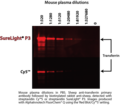Phycobilisome
Phycobilisome is a light-harvesting complex found in cyanobacteria and red algae. It is a part of the photosynthetic system and plays a crucial role in the process of photosynthesis.
Structure[edit]
Phycobilisomes are large protein complexes that are attached to the thylakoid membrane. They are composed of phycobiliproteins, which are a group of water-soluble proteins present in cyanobacteria and red algae. These proteins are responsible for capturing light energy and transferring it to the chlorophyll molecules.
The structure of a phycobilisome is highly organized. It consists of a core and several peripheral rods. The core contains allophycocyanin, while the rods contain phycocyanin and phycoerythrin.
Function[edit]
The primary function of phycobilisomes is to absorb light energy and transfer it to the photosynthetic reaction centers. They are particularly efficient at capturing light in the blue and green regions of the spectrum, which allows cyanobacteria and red algae to perform photosynthesis in deep water where these wavelengths of light are most available.
Phycobilisomes also play a role in the regulation of light energy. When the light intensity is too high, they can dissipate excess energy to prevent damage to the photosynthetic apparatus.
Significance[edit]
Phycobilisomes are of significant interest in the field of biotechnology. Due to their ability to absorb and transfer light energy efficiently, they have potential applications in solar energy conversion and optoelectronic devices.
In addition, phycobiliproteins are used as fluorescent markers in immunology, cell biology, and microscopy due to their high fluorescence quantum yield and stability.
| Photosynthesis | ||||||||||
|---|---|---|---|---|---|---|---|---|---|---|
This photosynthesis-related article is a stub.
|
This article is a Cyanobacteria-related stub. You can help WikiMD by expanding it!
-
Structure of a phycobilisome
-
Excitation and emission of phycobilisome
-
Phycobilisome Western blot
Ad. Transform your life with W8MD's Budget GLP-1 injections from $75


W8MD offers a medical weight loss program to lose weight in Philadelphia. Our physician-supervised medical weight loss provides:
- Weight loss injections in NYC (generic and brand names):
- Zepbound / Mounjaro, Wegovy / Ozempic, Saxenda
- Most insurances accepted or discounted self-pay rates. We will obtain insurance prior authorizations if needed.
- Generic GLP1 weight loss injections from $75 for the starting dose.
- Also offer prescription weight loss medications including Phentermine, Qsymia, Diethylpropion, Contrave etc.
NYC weight loss doctor appointmentsNYC weight loss doctor appointments
Start your NYC weight loss journey today at our NYC medical weight loss and Philadelphia medical weight loss clinics.
- Call 718-946-5500 to lose weight in NYC or for medical weight loss in Philadelphia 215-676-2334.
- Tags:NYC medical weight loss, Philadelphia lose weight Zepbound NYC, Budget GLP1 weight loss injections, Wegovy Philadelphia, Wegovy NYC, Philadelphia medical weight loss, Brookly weight loss and Wegovy NYC
|
WikiMD's Wellness Encyclopedia |
| Let Food Be Thy Medicine Medicine Thy Food - Hippocrates |
Medical Disclaimer: WikiMD is not a substitute for professional medical advice. The information on WikiMD is provided as an information resource only, may be incorrect, outdated or misleading, and is not to be used or relied on for any diagnostic or treatment purposes. Please consult your health care provider before making any healthcare decisions or for guidance about a specific medical condition. WikiMD expressly disclaims responsibility, and shall have no liability, for any damages, loss, injury, or liability whatsoever suffered as a result of your reliance on the information contained in this site. By visiting this site you agree to the foregoing terms and conditions, which may from time to time be changed or supplemented by WikiMD. If you do not agree to the foregoing terms and conditions, you should not enter or use this site. See full disclaimer.
Credits:Most images are courtesy of Wikimedia commons, and templates, categories Wikipedia, licensed under CC BY SA or similar.
Translate this page: - East Asian
中文,
日本,
한국어,
South Asian
हिन्दी,
தமிழ்,
తెలుగు,
Urdu,
ಕನ್ನಡ,
Southeast Asian
Indonesian,
Vietnamese,
Thai,
မြန်မာဘာသာ,
বাংলা
European
español,
Deutsch,
français,
Greek,
português do Brasil,
polski,
română,
русский,
Nederlands,
norsk,
svenska,
suomi,
Italian
Middle Eastern & African
عربى,
Turkish,
Persian,
Hebrew,
Afrikaans,
isiZulu,
Kiswahili,
Other
Bulgarian,
Hungarian,
Czech,
Swedish,
മലയാളം,
मराठी,
ਪੰਜਾਬੀ,
ગુજરાતી,
Portuguese,
Ukrainian



